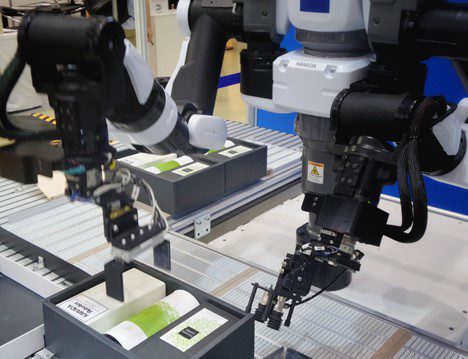
Unsplash)
 Shawn Dhue is an IPilogue Writer and a 2L JD Candidate at Osgoode Hall Law School.
Shawn Dhue is an IPilogue Writer and a 2L JD Candidate at Osgoode Hall Law School.
In light of the recent court decision of Thaler v Hirshfeld et al. [Apotex], I have decided to look at precedents from around the world where courts have contemplated recognizing artificial intelligence (AI) technology as an “inventor.” As will follow, Canada addressed this matter in Apotex Inc v Wellcome Foundation. However, this 2002 decision did not define whether AI technology can be an inventor. A lot has changed over the past nineteen years, and Judge Leonie Brinkema in Thaler gave some insight into what the future could look like for AI “inventors.”
United States: Thaler v Hirshfeld et al
On September 3, 2021, the United States District Court for the Eastern District of Virginia, lead by Judge Brinkema, ruled on the appeal made by Stephen Thaler. Thaler and his colleague, Ryan Abbott, created an AI creativity machine called Device for the Autonomous Bootstrapping of Unified Sentience (DABUS). The two creators listed DABUS as the inventor on two applications for patents for the inventions of a light beacon and a food container. In April 2020, the US patent office rejected the applications, stating that an inventor must be a human, not a robot:
Thaler replied that listing himself as the inventor rather than DABUS would be “falsely claiming credit.”
On appeal, Judge Brinkema agreed that Thaler and Abbott could not list DABUS as the inventor on a patent. Judge Brinkema states:
“Congrss intended to limit the definition of ‘inventor’ to natural persons. As technology evolves, there may come a time when artificial intelligence reaches a level of sophistication such that it might satisfy accepted meanings of inventorship. But that time has not yet arrived…”
This decision leaves the matter open to a future of possibility, giving a precedent that is easily changeable.
Australia: Thaler v Commissioner of Patents [2021] FCA 879
In February 2021, Thaler filed an application for the same patent in Australia. Johnathan Beach J of the Federal Court of Australia ruled that “the name of the inventor can be a non-human.” Continuing, Beach J explains that “an inventor as recognised under the [Patents Act 1990] can be an artificial intelligence system or device. But such a non-human inventor can neither be an applicant for a patent nor a grantee of a patent.” This decision was a historic ruling in Australia. The Commissions’ Office says they will appeal the decision.
United Kingdom: Thaler v The Comptroller-General of Patents, Designs and Trade Marks [2020] EWHC 2412 (Pat)
In September 2020, a UK judge dismissed Thaler’s appeal to the decision rejecting his applications. The judge stated that DABUS is not the inventor and cannot be the inventor. Justice Marcus Smith explained his reasoning by saying that the meaning of the word “inventor” is limited to people under UK patent law.
Canada: Apotex Inc v Wellcome Foundation Ltd [2002] 4 SCR 153
As mentioned, Apotex was the most recent Supreme Court of Canada decision that spoke to humans being inventors for patent applications. However, this decision did not directly speak to the question of whether AI technology could be encompassed under the definition of “inventor.” Binnie J, for the Court, stated that “[the Court] infer[s] that the inventor is the person or persons who conceived of the “new and useful” art, process, machine, manufacture or composition of matter, or any “new and useful” improvement thereto” [emphasis added].
With that said, by way of Judge Brinkema’s comments and the precedents of the Federal Court of Australia, I believe there is a strong argument for allowing AI technology to be considered an inventor. Canada classifying AI technology as inventors would create a strong push for new AI technology. Canada’s patent law is not currently prepared to deal with such a progression; however, as technology advances, amendments are likely to follow.


2 Responses
The UK first instance decision denying patentability has just been affirmed: Thaler v Comptroller General of Patents Trade Marks And Designs [2021] EWCA Civ 1374.
The issue of inventorship in the age of A.I. is highly nuanced. On the one hand, arguments in favour of recognizing A.I. as inventor have merit given the fact that in many instances, the A.I. system is the entity that conceives of the inventive solution with little to no human interference. This is particularly true when deep-learning tools are utilized to produce outcomes. Deep-learning systems are often opaque to humans because the process that renders an output is generated by the system itself. Hence, in instances where deep-learning tools are employed, the question would be: “If the A.I. system is not the inventor, who is?”
In several jurisdictions, including Canada, a patent for an invention may only be granted to the inventor or the inventor’s legal representative. In the U.K., under section 7(2) of the Patents Act, a patent may be granted primarily to the inventor, a person entitled to the whole of the property by virtue of any law or agreement (e.g., the inventor’s employer), or the successors in title of the aforementioned persons. Therefore, identifying the inventor or co-inventors is necessary for making an application for a patent.
On the other hand, recognizing A.I. as inventor would have serious consequences in the way we interpret patent law statutes. As you mentioned, the U.S. District Court in Thaler v. Hirshfeld noted that recognizing A.I. as inventor would contradict the plain reading of the term “individual” in the Patent Act. Additionally, from a business perspective, given that the legal rights granted in a patent flow from the concept of inventorship, recognizing A.I. as inventor would have serious implications for the assignment or licensing of patent rights in a commercial setting.
Given all the global developments in this area, hopefully we will soon have some clarity about Canada’s stance on the issue, either through court rulings or an Act of Parliament.